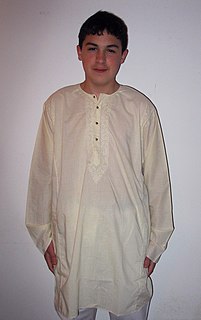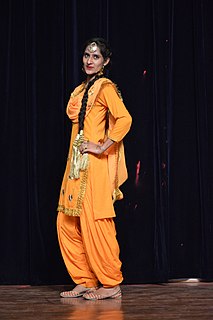Related Research Articles

Calico is a plain-woven textile made from unbleached, and often not fully processed, cotton. It may also contain unseparated husk parts. The fabric is far coarser than muslin, but less coarse and thick than canvas or denim. However, it is still very cheap owing to its unfinished and undyed appearance.

Muslin is a cotton fabric of plain weave. It is made in a wide range of weights from delicate sheers to coarse sheeting. It gets its name from the city of Mosul, in Iraq, where it was first manufactured. In the 17th and 18th centuries Dacca in Bengal was regarded as producing the finest muslins.

A kurta is a loose collarless shirt worn in many regions of South Asia, and now also worn around the world. Tracing its roots to Central Asian nomadic tunics, or upper body garments, of the late-ancient- or early-medieval era, the kurta has evolved stylistically over the centuries, especially in South Asia, as a garment for everyday wear as well as for formal occasions.

Chintz is a woodblock printed, painted, stained or glazed calico textile that originated in Golconda in the 16th century. The cloth is printed with designs featuring flowers and other patterns in different colours, typically on a light, plain background.

Phulkari refers to the folk embroidery of the Punjab. Although Phulkari means floral work, the designs include not only flowers but also cover motifs and geometrical shapes. The main characteristics of Phulkari embroidery are use of darn stitch on the wrong side of coarse cotton cloth with coloured silken thread. Punjabi women create innumerable alluring and interesting designs and patterns by their skilful manipulation of the darn stitch. According to Kehal (2009), a cloth where only a few flowers are embroidered is called a Phulkari. The other types are distinct varieties. The traditional varieties of Phulkaris are large items of cloth and include Chope, Tilpatr, Neelak and Bagh. Sometimes, the Bagh is given separate categorization of its own as on other varieties of a Phulkari, parts of the cloth is visible, whereas in a Bagh, the embroidery covers the entire garment so that the base cloth is not visible. Further, in contemporary modern designs, simple and sparsely embroidered dupattas, odhinis, and shawls, made for everyday use, are referred to as phulkaris, whereas clothing items that cover the entire body, made for special and ceremonial occasions such as weddings are called baghs. The Phulkari continues to be an integral part of Punjabi weddings to the present day.

Rahon is a city and a municipal council in the district Shaheed Bhagat Singh of the Indian state of Punjab. Rahon is in Doaba region of Punjab. Doaba also known as Bist Doab, is the region of Punjab, India that lies between the Beas River and the Sutlej River.

In the ancient Punjab region, people wore cotton clothing. The tops lied till knees for both the genders. A scarf was worn over the tops which would be draped over the left shoulder and under the right. A large sheet would be further draped over one shoulder which would hang loose towards the knees. Both sexes wore a dhoti around the waist. Modern Punjabi dress has retained this outfit but over its long history has added other forms of dress.
Bafta is a kind of calico, initially made in India.
Khasa was a high-quality variety of calico cloth that was manufactured and used for clothing in the Mughal Empire.

Khes is a thin cotton blanket cloth of the Indian subcontinent; it is a damask cloth used for blankets and winter wraps. Khes is generally hand-woven with coarse cotton yarns. Khes as a garment is a simple clothing item to wear loosely to cover upper body parts by men in Pakistan and Punjab, India. Khes is an important cloth of Punjab region, a region which is famous for its production and historically has been known for not only the production of Khes but also many other coarse cotton textiles, especially in the 19th and 20th centuries. Khes is a comfort object used in bedding, and also usable as a cover.
Sussi or susi was a term for multicolored striped or checked cloth produced in the Indian subcontinent. Sussi was thin handloom fabric made of cotton, silk, or a blend of the two, with colored warp stripes. Punjab region was known for its production and exports during the Mughal period. Sussi was most often made with red and blue, blue and white, or green and white stripes, but other patterns were also produced. The fabric was exported to England, where sousaes were in great demand in the 18th century.

Piece goods were the textile materials sold in cut pieces as per the buyer's specification. The piece goods were either cut from a fabric roll or produced with a certain length, also called yard goods. Various textiles such as cotton, wool, silk, etc., were traded in terms of piece goods. The prices were determined as per the fabric quality.
Gulbadan was a kind of striped silk produced in Hindustan. The gulbadan was a light textured cloth of silk and cotton. Gulbadan has vertical variegated stripes with a different color than the base color of the cloth. In appearance, it was similar to a glazed calico, unlike Mashru, which has the satin (lustrous) surface.The contemporary silk piece goods were Daryai and Dhupehan. Gulbadan was available in many color combinations and sizes. Gulbadan of Amritsar and Lahore were famous.

Izarband(naada, izārband, Izar band, Kamarband, Kamar Ki Patti and Patka, ازار بند) is a kind of girdle. Izarband is used to tie the upper part of various dresses such as salwar, pajamas, ghagra, petticoat, etc., in the Indian subcontinent. The said garments have the upper side turned inwards and stitched to make a narrow tubular passage, in which the izarband passes, there is one opening in the front side to collect and tie/ knot the ends. Izarband was one of the accessory (closures) items of textiles produced in the Punjab region. The Izarband is similar to a drawstring but narrower than a katzeb or a sash.
Dosuti was one of the coarser cotton piece goods produced in the Indian subcontinent. Originally, it was a handspun and handloom cloth made in the villages. Punjab was having various cotton qualities during the 19th century. All were distinguished with their weight, thickness, and the yarn. Dosuti was a cloth made by running two yarns in warp and weft as its name refers to Do(double) Suti. India's Eastern side was famous for more delicate cotton materials such as Dacca muslins, and Punjab and Gujarat were famous for coarser cotton textile piece goods. Dosuti was a thick cotton material used for rough usages, such as duster. The other contemporary cotton products were Eksuti, Tinsuti, and Chausuti, etc.

Mashru is a woven cloth that is a mix of silk and cotton. Historically, it was a hand-woven satin silk fabric variety found in the Indian subcontinent, and its proper use is described in the 16th-century Ain-i-Akbari.
Gazzi cloth was an old handloom cloth; It was among indigenous coarse cotton varieties from Punjab.
Gaji is a coarse cloth mainly made with cotton or silk, used for native dresses in India.
A Rampur chaddar was a kind of handspun woolen shawl that originated in the town of Rampur in Himachal Pradesh, India, during the 19th century. They were later manufactured in cities of the Punjab such as Ludhiana and Amritsar, and also imported from outside India.
Salu is a type of twill cloth, woven from cotton and dyed red, originally made in India. Prior to the introduction of modern industrial techniques, it was produced exclusively hand spun (khaddar) yarns with locally-available dyes. Salu is one of seven cotton cloths explicitly mentioned in the 16th century Mughal record Ain-i-Akbari, together with khasa, tansukh, doriya, bafta, dupatta, and panchtoliya.
References
- ↑ Peck, Amelia (2013). Interwoven Globe: The Worldwide Textile Trade, 1500-1800. Metropolitan Museum of Art. p. 305. ISBN 978-1-58839-496-5.
- ↑ Rømer, Ludvig Ferdinand; Mer, Ludewig Ferdinand R. (2000). A Reliable Account of the Coast of Guinea (1760). British Academy. p. 266. ISBN 978-0-19-726218-4.
- ↑ Chisholm 1911, p. 974.
- ↑ "LONGCLOTH - Definition and synonyms of longcloth in the English dictionary". educalingo.com. Retrieved 2020-10-21.
- ↑ "Canada Canvas Photo Prints, Custom Made Picture Frames & Plaque Mounts, Face Mounting Prints On PlexiGlass". www.canadaoncanvas.com. Retrieved 2020-10-21.
- ↑ Watt, George Sir; Brown, Percy (Illus ) (1903). Indian Art at Delhi, 1903; being the Official Catalogue of the Delhi Exhibition, 1902-1903. Superintendent of Government Printing (Calcutta). p. 522.
- ↑ Mukhopādhyāẏa, Trailokyanātha (1888). Art-manufactures of India: Specially Compiled for the Glasgow International Exhibition, 1888. Superintendent of Government Printing. pp. 322, 317, 354.
- ↑ Punjab (India) (2006). Punjab District Gazetteers: Nawashahr. Controller of Print. and Stationery. p. 137.
- ↑ Official Report of the Calcutta International Exhibition, 1883-84: Compiled Under the Orders of the Executive Committee. Bengal Secretariat Press. 1885. pp. 415, 417.
- 1 2 3 Baden-Powell, Baden Henry (1872). Hand-book of the Manufactures & Arts of the Punjab: With a Combined Glossary & Index of Vernacular Trades & Technical Terms ... Forming Vol. Ii to the "Hand-book of the Economic Products of the Punjab" Prepared Under the Orders of Government. Punjab printing Company. pp. 21, 16.
- ↑ Mukharji, Trailokya Nath (1888). Art manufactures of India. Harold B. Lee Library. Calcutta: Government printing. p. 322.
- ↑ Nanda, Reena (2018-02-10). From Quetta to Delhi: A Partition Story. Bloomsbury Publishing. ISBN 978-93-86643-44-5.
- ↑ Kashmir. 1952. p. 258.
- ↑ ''Men ' s dress - Tribesmen normally wear very simple dress which is usually made of coarse cloth or latha cloth .'' Page 16https://www.google.co.in/books/edition/Population_Census_of_Pakistan_1961_West/07IZAAAAMAAJ?hl=en&gbpv=1&bsq=latha+cloth&dq=latha+cloth&printsec=frontcover
- Attribution
- This article incorporates text from a publication now in the public domain : Chisholm, Hugh, ed. (1911). "Longcloth". Encyclopædia Britannica . 16 (11th ed.). Cambridge University Press. p. 974.


